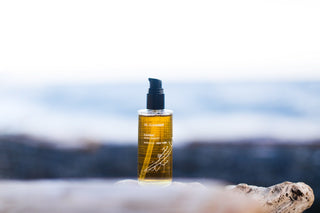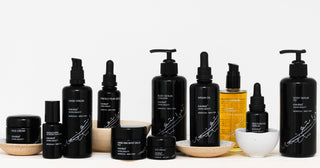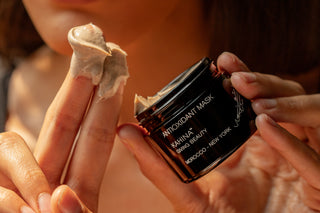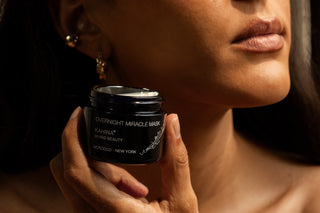
To recap skincare school thus far, we've been over:
Our next topic? Masks!
Why use a face mask?
Because isn't it fun to scare your loved ones with a different colored face?! No, that's just a fringe benefit. We consider masks like a ginger shot or a massage: an occasional, concentrated boost to round out your routine. There are many different kinds of masks on the market that can help with your particular skin concerns: exfoliating, moisturizing, clarifying, etc. Your daily skincare routine should be relatively simple and consistent; masks are a way of introducing variety without disturbing the equilibrium, and getting some extra results to boot.
How often should I use a face mask?
Depends on the mask. If it's a gentle, moisturizing mask and you are doing some intensive treatment, up to three times a week. If it's an exfoliating mask, or one with acids, once a week should be fine. For clarifying masks, if you have resilient skin, twice a week. Basically, use the mask as much as you like, with the caveat that you should never irritate your skin; if you're experiencing redness, sensitivity, burning, etc. scale back on frequency. We like to use Kahina Antioxidant Mask once or twice a week.
We're mask-happy over here; while some might consider a mask a secondary, non-essential product for their skincare regimen, we beg to differ. In fact, we encourage 99.99% of our customers to include
Kahina Antioxidant Mask in their weekly routine. (That 0.01% is the ultra-sensitive.)
Benefits of Kahina Antioxidant Mask:
- physical exfoliation
- decongesting and detoxing
- moisturizing
- clarifying and brightening
Unlike some clay masks that are packaged as a dry powder that you need to rehydrate, we've done that work for you, carefully formulating the liquid component of the mask to get maximum benefits. Moroccan Rhassoul Clay attracts impurities just like any other clay, but it is not drying the way bentonite (
looking at you, Aztec Secret) or even kaolin clays can be. Your face will not feel like it's pulsing and about to burst. Instead, because we've mixed it with moisturizing argan oil (full of essential fatty acids), plus antioxidant-rich and calming pomegranate and acai, you're doing a detox-moisturizing-exfoliating mask all in one. When you've left it on the requisite 5-10 minutes, you gently buff away and you should see clearer, more even skin.
Enough tooting our own horn, though. There are other masks on the market and we want to give you a primer on navigating the mask aisle (don't you wish there were a mask aisle?!).
CLAY
Who benefits from a clay mask?
Most clay masks are fairly drying, so for that reason, we typically recommend them for normal to oily skin types. If dry skin types are using a powder-based clay mask (one that needs to be rehydrated before using), they should mix it with some oil - argan would work well - in addition to soothing liquids (Kahina Toning Mist would work, or aloe vera juice or rosewater - never vinegar!) to counteract the drying properties of clay. Rhassoul clay is recommended for dry or sensitive skin types. Clay has been shown to attract and remove impurities that can contribute to inflammation and even acne. Clay is naturally exfoliating.
Look out for...
one more time: clay can be very drying and irritating. If it's leaving your skin red, dry, tight, or sensitive, use the mask for less time and avoid letting it dry completely on your skin to where you have to crack it off or scrub vigorously to remove it.
ENZYME
Who benefits from an enzyme mask?
Enzymes are actives meant to dissolve surface dead skin cells, revealing brighter, more even-toned, softer skin. Enzyme masks are wonderful for devitalized (dull-looking) skin, combination, oily or acneic skin types, and slightly dry skin. We don't love them for sensitive skin, unless the enzymes have been specifically formulated for sensitive skin. Enzyme masks can be an effective form of exfoliation.
Look out for...
Enzymes can be hard to preserve, meaning that by the time you receive the product, the actives might no longer be effective. Depending on what else the mask is mixed with, you might notice fringe benefits like more moisture or some exfoliation thanks to clay or powders, but you aren't getting enzymatic exfoliation. Buy from brands you trust and feel free to ask them nicely how their enzymes are preserved.
MOISTURIZING
Who benefits from a moisturizing mask?
Dull, dehydrated, dry, flaky, or sensitive skin types. If you've been using retinoids or chemical exfoliators, a moisturizing mask might be in order to soothe irritated skin and reduce flakiness. Moisturizing masks can feel particularly nice after too much sun or wind exposure, or time spent in dry, dehydrating environments.
Look out for...
If you're prone to acne or clogged pores, use the same discretion in choosing a moisturizing mask as you would a moisturizer. Avoid your particular trigger ingredients (could be coconut oil, plant butters, waxes, emulsifiers).
CLARIFYING
Who benefits from a clarifying mask?
A clarifying mask (detox mask is another common name) is a broad category and can overlap with clay or enzyme masks. A clarifying mask is perfect for oily, acne-prone skin types and for dehydrated or uneven skin tones, especially anyone that lives in a large city and is exposed to pollutants daily. A hallmark feature of clarifying masks is that they are exfoliating, oftentimes combining some sort of enzyme or chemical exfoliant with a physical exfoliant.
Look out for...
Clarifying masks that also contain soothing, anti-inflammatory ingredients so your skin is clearer and less red even after the first use.
Pro tip:
Sometimes we like doing a double mask. Choose the more physically exfoliating mask first - perhaps a clay or clarifying mask. Then follow it up with an enzyme or moisturizing mask.
What should I do before and after I mask?
Start with a clean face. Some people like to steam their faces before masking. Use the mask, then follow up with a hydrating toner (like Kahina Toning Mist) and then your oil and moisturizer of choice. If we're doing Kahina Antioxidant Mask before an event, we like to start with Kahina Facial Cleanser, then mask, then use Kahina Toning Mist and Serum (maybe mix some Prickly Pear Seed Oil in there too, for good measure!).
 To recap skincare school thus far, we've been over:
To recap skincare school thus far, we've been over:




